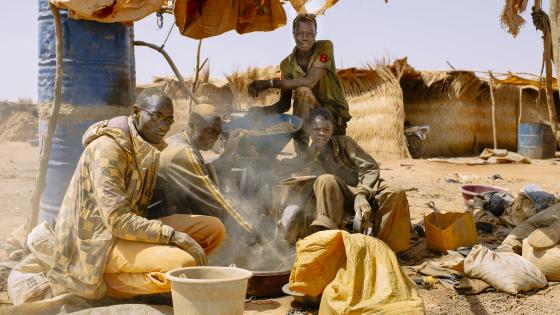An extensive literature has not only shown that natural resources can exacerbate challenges of macroeconomic management, but points to a fundamental problem faced by producers of natural resources: how to transform subsoil wealth into productive assets such as financial, human, and physical capital (van der Ploeg and Venables 2012). The financial sector has been shown to have a critical role in intermediating domestic savings into domestic investment and in allocating scarce resources effectively, with positive repercussions for economic growth (Levine 2005). The financial system should thus serve as an important absorption tool for windfall gains, such those as arising from natural resource rents.
In recent research, we gauge whether natural resource windfalls are associated with deeper financial intermediation, using a panel dataset of over 150 developed and developing countries over the period 1970 to 2008 (Beck and Poelhekke 2017). While previous papers have shown a negative relationship between natural resource abundance and financial sector development (Beck 2011, Bhattacharya and Hodler 2014), endogeneity challenges have prevented researchers from drawing causal inferences. Using a novel methodology to isolate exogenous changes in natural resource rents and applying structural VAR methods allows us to address concerns related to cross-country explorations of the relationship between natural resources and financial development and make statements beyond simply correlations.
A natural resource curse in finance?
Theory makes contradictory predictions of financial development in countries rich in natural resources. On the deposit and funding side, higher natural resource rents can result in higher deposit funding for a country’s banking system if they are saved domestically. They might also lead to higher loan demand, especially consumer credit, thus deepening the financial system. Moreover, there is evidence that natural resource booms lower constraints to international borrowing by increasing collateral and raise public demand for loans (Mansoorian 1991, Manzano and Rigobon 2007). On the other hand, windfall gains can also lead to a shift of wealth out of the domestic financial system, either into foreign investment conduits and offshore sovereign wealth funds, or into non-financial wealth, especially in the case of inefficient financial sectors. In addition, the traded sector might suffer as natural resource rents lead to more resource extraction, crowding out of the non-resource sector and thus resulting in lower demand for external finance. Finally, the heavy dependence of the financial system on a sound institutional framework, including an effective contractual framework, can hamper financial deepening in countries where natural resource abundance undermines institutional development.
However, it is far from clear that this is a causal relationship. There could be lower demand for financial services in resource rich countries. Also, the negative relationship could be simply driven by institutional underdevelopment in resource-rich countries, so that the financial sector is just ‘another victim’ of natural resource specialisation, but with no evidence for an independent ‘natural resource curse in finance’.
How to measure resource rents and windfall gains?
The literature has used different indicators to measure the reliance of economies on natural resources, ranging from the export share of natural resources in total exports to the importance of sub-soil wealth in a country’s total wealth and giant oil field discoveries. In cross-country growth regressions on the long-run impact of natural resource wealth, these have been criticised for their lack of exogeneity as they are based not only on exogenous geology, but also on exploration effort, technology, and extraction costs (van der Ploeg and Poelhekke 2010).
We therefore focus on the price component of changes in resource rents. Specifically, we use data from World Bank (2011), where resource rents are computed as total production times the world price net of unit cost of production, and all components are observed. We split the log change of resource rents into (i) the log change in the Paasche price index of metals and minerals, with base year for prices (but not weights) set to 1970, to capture windfalls due to exogenous world price shocks, (ii) the log change in metal and minerals revenue (value of production) divided by the Paasche price index of metals and minerals, which indexes windfalls due to changes in production, and (iii) the log change in Paasche unit production cost index of metals and minerals, with base year for costs set to 1970.
In our empirical analysis, we focus on the change in the country- and year-specific price index as a gauge of natural resource windfalls. The decomposition shows that price shocks are by far the most important component, as a one percentage point change in prices leads to more than twice as high a change in rents as a one percentage point increase in quantity, and almost four times as high a change in rents as a one percentage point reduction in costs.
We relate annual changes in resource rents due to price, quantity, and cost changes to changes in different indicators of financial development as well as macroeconomic indicators, using dynamic panel regression as well as VAR and structural VAR models, where in the latter we allow for feedback effects between deposit taking and lending by banks, inflation and GDP growth.
Our findings
Using a panel dataset of over 150 developed and developing countries over the period 1970 to 2008, we find:
- A relative decline in the volume of financial sector deposits in countries that experience an unexpected natural resource windfall. While financial system deposits tend to increase following the windfall (which is the optimal response to a transitory shock), comparing countries with similarly booming economies as captured by total GDP growth, we find that those countries where the boom is induced by an unexpected positive shock to the exogenous world price of its basket of natural resources experience a relative decline in private financial sector deposits;
- A relative decline in the volume of private-sector lending, although the decline in lending is mostly due to the decrease in deposits;
- That these country-level results hold across different types of deposits, that they are confirmed with bank-level regressions and independently of bank characteristics, that they are robust to controlling for news about natural resource discoveries, to dropping major mineral exporters, and to the existence of sovereign wealth funds;
- Important cross-country variation in that our findings hold primarily for countries with less developed institutional frameworks and repressed financial systems;
- Evidence that foreign assets and government deposits with commercial and central banks increase following a natural resource price shock;
- That the higher government deposits with commercial and central banks results in higher government consumption, but this in turn does not lead to more private lending;
- That our results are not only statistically but also economically significant. Compared to the counterfactual of a country growing at similar speed, a doubling of commodity price inflation induces a relative decline of deposit growth by 3.4%, but increases relative growth of foreign assets by 9.6% and government deposits with central banks by 19.3%, which in turn raises government consumption but not private lending.
Conclusions
Overall, this seems clear evidence that unexpected exogenous windfalls from natural resource rents are not intermediated. These findings are consistent with the negative long-term relationship between the reliance of a country on natural resources and financial sector development as well as the government as major beneficiary of natural resource booms, while at the same time undermining the financial intermediation process. They also send a powerful policy message – institution building and regulatory reform is even more important in resource-rich countries, if the financial system is to fulfil its critical role in intermediating society’s savings for the benefit of long-term inclusive growth.
References
Beck, T (2011), “Finance and Oil Is There a Natural Resource Curse in Financial Development?”, in R Arezki, T Gylfason and A Sy (eds), Beyond the Curse: Policies to Harness the Power of Natural Resources, Washington DC: IMF, 81-106
Beck, T and S Poelhekke (2017), “Follow the Money: Does the Financial Sector Intermediate Natural Reource Rents? “, CEPR Discussion paper, forthcoming.
Bhattacharyya, S and R Hodler (2014), “Do Natural Resource Revenues Hinder Financial Development? The Role of Political Institutions”, World Development 57: 101-113.
Levine, R (2005), “Finance and growth: Theory and evidence”, in P Aghion and S Durlauf (eds), Handbook of Economic Growth. The Netherlands: Elsevier Science.
Mansoorian A (1991), “Resource discoveries and ‘excessive’ external borrowing”, Econonmic Journal 101:1497–509
Manzano O and R Rigobon (2007), “Resource curse or debt overhang”, in D Lederman and W F Maloney (eds) Natural Resources: Neither Curse nor Destiny, Washington, DC: World Bank, pp. 41–70.
Van der Ploeg, F and A J Venables (2012), “Natural Resource Wealth: The Challenge of Managing a Windfall”, Annual Review of Economics 4: 315-337.
Van der Ploeg, F and S Poelhekke (2010), “The pungent smell of 'red herrings': Subsoil assets, rents, volatility and the resource curse”, Journal of Environmental Economics and Management 60(1): 44-55.
World Bank (2011), The Changing Wealth of Nations: Measuring Sustainable Development in the New Millennium. Washington, DC: World Bank.




